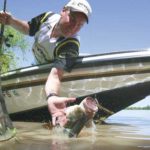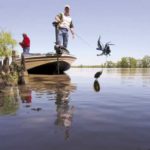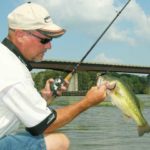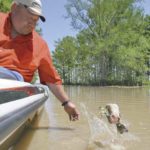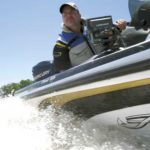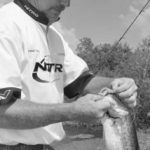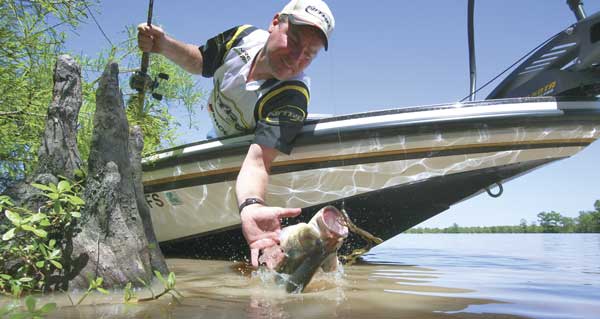
The Mermentau River was dealt a near-death blow by Hurricane Rita, but its bass population has bounced back stronger than ever.
Nobody would ever confuse the Mermentau River with a sprawling reservoir that attracts bass anglers from all across the nation.At the Mermentau, there are no fancy resorts on its banks, there are no guides with more patches than Tony Stewart and there are no double-digit bass destined for den walls.
If the Mermentau River could talk, though, we would find that it’s pretty comfortable in its own skin. This is the kind of water that is better at being what it is than trying to be what it isn’t.
And to the locals who know it well, what it is is just alright with them.
“We always hear people from other places talking about how they can’t catch anything on the river,” said Jennings angler Bobby Vasseur. “They keep on driving by to fancier places like Toledo Bend. Our local anglers know what we’ve got here, though, and what we’ve got is a great place to catch some bass.”
What the locals have right now is a far cry from what they had just a few years ago. Hurricane Rita slammed the river, which was once such a great place to go pick up a 3- or 4-pound bass, hard in 2005. While the Mermentau wasn’t ever known for its numbers of fish before that, it did have a lot of good quality bass in it. That reputation was all but wiped out by the storm.
Like many other areas along coastal Southwest Louisiana, Hurricane Rita sucked the life out of the Mermentau River. Dead fish crowded the canals for weeks, and any signs of vibrant animal or plant life were absent immediately after the storm.
One angler who got a first hand look at the devastation was 10-time Louisiana BASS Federation State Team Qualifier Dennis Tietje of Roanoke.
“Our bass fishing went down to absolutely nothing,” he said. “Anybody who went fishing would literally go days without getting a bite. The oxygen depletion caused by all the leaves in the water was what got the fish. And the lower part of the river is so shallow that it churned up all the silt on the bottom. Once that silt got on their gills, that was it.”
What Tietje, Vasseur and others soon discovered, though, was that there were some small pockets of bass that survived. Tietje theorized that these were fish that rode out the storm in some of the protected pockets within the surrounding marshes and swamps. He believes those areas held enough good water to keep some fish alive.
Since then, these same pockets have provided bass a place to spawn unmolested. And, according to Tietje and Vasseur, it is the offspring of these survivors that has fueled the dramatic rebirth of the Mermentau River. It is in many ways a river reborn.
Beginning late last year, Tietje, who is also a two-time National BASS Federation qualifier and a member of the Nitro National Team, started having some of the most spectacular days of his fishing life on the Mermentau. Seventy- and 80-fish days were limited to that count only because of his need to get back to his crawfish farm. If he could have spent more time, he would have caught even more.
“What we had was a tremendous number of small fish last year,” Tietje said. “I would say they were all about 1 1/4 to 1 1/2 pounds. We saw an increase in the numbers of the same size fish. Already this year, we’re seeing a huge increase in one size bigger fish — there are a lot of 2-pounders right now. As we go on, we’ll see the size continue to increase. The fish will begin to scatter more, though, as they get larger.”
The tendency for small fish to group up together is what’s driving the insane numbers being caught right now. During a recent tournament, Tietje and Vasseur caught approximately 60 fish. The fact that they caught 20 fish per spot and only caught fish in those three spots speaks volumes about what’s going on at the Mermentau.
“Last year we may have found five good pockets of fish around the entire river,” said Vasseur. “This year we’re finding more than that. And the amazing thing is that once we got on these spots, we caught all our fish in fewer than 30 minutes and from areas about the size of a pickup truck. I think in the future, we’re going to find fewer fish per pocket but more pockets around the lake.”
While the rebounding of the Mermentau is well under way, the river still experiences the same conditions that made it a tough nut to crack before Hurricane Rita. The one condition that tends to turn the most people away is the chocolate milk-colored water that dominates the water at certain times of the year.
Much of the mud comes from local farmland runoff, as the water in the river doesn’t come from far-away sources. There is no big flow of water into the system from a northern headwater, and the river experiences very little current as a result. But just like farms are a part of the region, Tietje says a muddy Mermentau is what’s expected.
“I wouldn’t say it’s stagnant,” he said, “but it can get that way during drought situations. But once that mud gets in the lake, it doesn’t have the natural flushing mechanisms to help it clear out. It kind of just sits there and takes a long time to settle, especially since each new rainfall washes more mud into the river.”
The water really only clears up for a few months out of the year, and late summer through early winter are the best times to fish the river if you have to have clearer water. Any other time, anglers either adapt to the muddy conditions, or they go elsewhere. More often than not, they find some other water to fish.
Tietje and Vasseur believe that if anglers are to take advantage of the rebirth of the Mermentau River, they have to learn how to deal with the muddy water. While the mud scares other anglers away, it actually makes fishing a little bit easier for these two anglers.
“People see all this mud, and they think there’s no way they can catch fish here,” Vasseur said. “But if you understand that the mud makes the bass hold tighter to cover, it makes it kind of obvious where you can find fish. Because they don’t have a lot of vision, they get up next to the hard wood cover and sometimes the grass patches to make themselves feel a little more comfortable.”
If the bass are tight to cover in the muddy water, that means a lure has to be presented tight to that same cover if an angler expects a fish to find it. Tietje calls it being “target specific,” which to him means placing his lure into specific locations that are close to his targets.
“Sometimes, being 5 inches away from the cover is a long way,” said Tietje. “As a general rule, many anglers don’t even fish that tight to cover because they’re scared of getting hung and losing a lure. If you’re not target specific out there, though, you’re going to struggle — two inches too far to the left or right and you won’t get bit.”
Another tactic that Vasseur uses to catch fish in the near-zero visibility conditions is to make multiple casts to the same piece of cover. This actually serves two roles. First, it gives any bass on the cover multiple chances to find his lure, and it forces him to take advantage of the multiple bass that are often found on one single piece of cover.
“If you pull up to a cypress tree and throw one time then move on, you’re assuming there aren’t any fish there,” Vasseur said. “Well, in this mud, it might take five or six casts before you trigger a bass to bite. If you do this with some kind of lure that moves a lot of water like a big Brush Hog or a spinnerbait, you’ll catch more fish.”
And it is that staying put on a fish or two that can turn a five-fish day into a 50-fish day. According to Tietje, he catches many of his fish on what many would assume is just one stick in the water. Multiple casts to the same stick produce multiple bites. It’s almost as if every fish in the area is holding on that one piece of cover.
“The worst thing you can do out there is to catch a fish and keep moving down the bank,” said Tietje. “If you’re not paying attention, you could pass up no telling how many fish that you would have caught if you had just stayed put.
“And just because you only see one stick in the water, that doesn’t mean it’s the only stick. For every one stick you see like that, there may be 100 more that you can’t see underwater. And if that’s where the fish are feeding, that’s where you need to be fishing.”
While Tietje used an isolated stick as an example, he and Vasseur consider the three main kinds of cover or structure on the Mermentau River to be cypress trees, the mouths of cuts and points. If anglers can learn how to fish these three with the river’s most productive lures, they will understand why the locals don’t mind staying home to fish.
Cypress trees literally line the entire bank of the Mermentau River system. Therefore, they play a prominent role in bass-fishing patterns. While many anglers may hit the downcurrent side of each tree and move on, Vasseur says that can be a mistake if the fish are actively feeding.
“When they’re really on, we like to take a more aggressive approach and hit all the different angles on a tree with a spinnerbait,” Vasseur said. “We do the same thing with the cypress knees. If the fish don’t respond to our spinnerbaits, we slow down and go to the flipping presentations with big plastics like a Brush Hog, still hitting all the different angles.”
The Mermentau River is loaded with cuts that drain the surrounding marshes and swamps. If an inexperienced angler is going to have 60- and 70-fish days, these cuts are where it’s going to happen. The key is to find the cuts that are draining clear water that mixes into the muddy water.
“Bass use that mixing line as cover,” Tietje said. “They’ll sit back in the muddy water and rush out to get anything that washes out of the cut in the clear water. The bite in the cuts can be on just about anything you want to throw.
“I like moving baits because the fish are so active. Topwaters work well if the fish are visibly feeding on the surface. Spinnerbaits work. Rat-L-Traps work. Just about anything you can chunk and wind will work in the cuts if the fish are there and eating.”
Points become more productive during the summer, and Vasseur says the bass will shift from point trees to land points. Bass stack up on the point trees in late spring and early summer, but they move to the bank points, fingers of land that stick from the bank out into the water, during late summer.
“It’s hard to beat a spinnerbait on the points no matter if it’s tree points or land points,’ Vasseur said. “And one thing I’ve found about fishing the muddy points is that a spinnerbait works best when it’s bright and sunny. The light penetrates down and makes the blade flash more, and I think that helps the fish find the lure easier.”
Tietje and Vasseur’s must-have lures are a 1/4-ounce Humdinger spinnerbait in white, white/chartreuse or white/chartreuse/blue, a Texas-rigged red shad worm and some kind of topwater like a buzz bait, a Chug Bug or a frog. There are others that may work well, but they consider these to be mainstays that will produce when others don’t.
The Mermentau River may not get the accolades of other bass-rich bodies of water in Louisiana, but the locals say that’s just fine with them. It’s not Toledo Bend, but it never claimed to be.
But like Toledo Bend, the Mermentau River will get back up every time it’s knocked down. It is just as resilient as the people who fish it.
